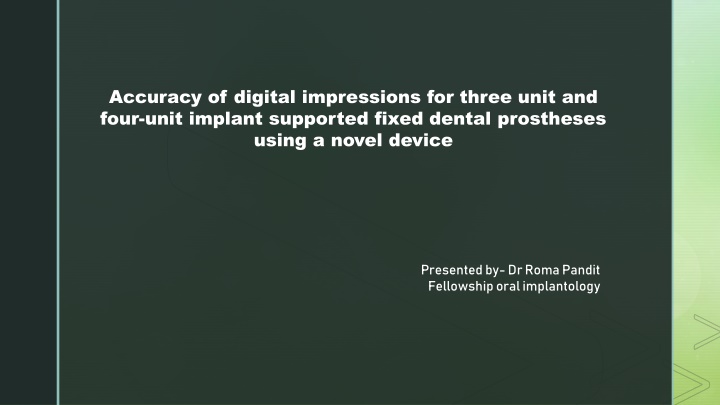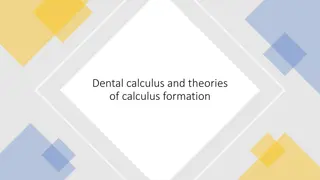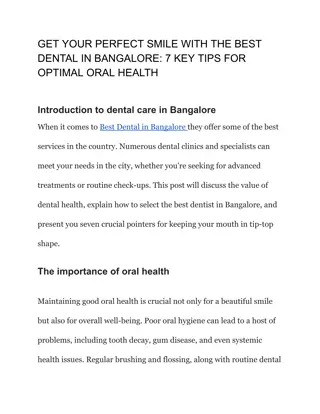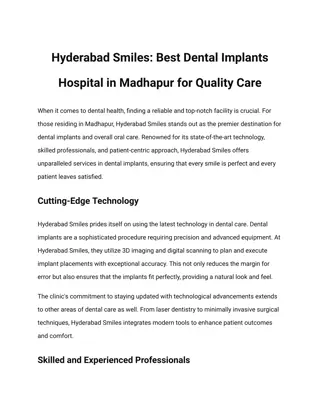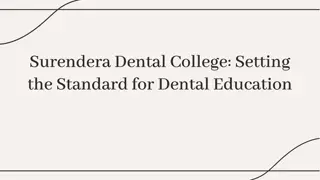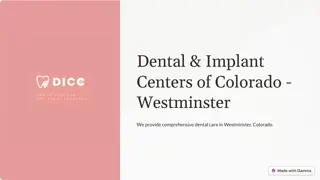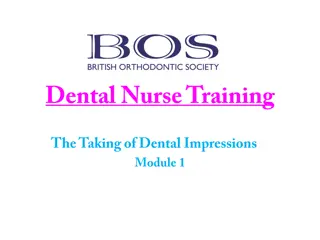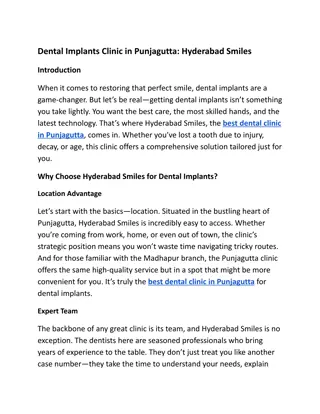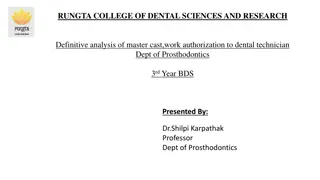Accuracy of Digital Impressions for Implant-Supported Fixed Dental Prostheses
The study presented by Dr. Roma Pandit explores the accuracy of digital impressions for three-unit and four-unit implant-supported fixed dental prostheses using a novel device. Digital impressions offer advantages over conventional methods, but challenges exist in scanning edentulous areas accurately. The article discusses methods to improve accuracy, such as pressure indicating paste, artificial landmarks, auxiliary devices, and splinting the scan body. The materials and methods section details the model preparation for the study to enhance accuracy in digital impressions.
Download Presentation

Please find below an Image/Link to download the presentation.
The content on the website is provided AS IS for your information and personal use only. It may not be sold, licensed, or shared on other websites without obtaining consent from the author.If you encounter any issues during the download, it is possible that the publisher has removed the file from their server.
You are allowed to download the files provided on this website for personal or commercial use, subject to the condition that they are used lawfully. All files are the property of their respective owners.
The content on the website is provided AS IS for your information and personal use only. It may not be sold, licensed, or shared on other websites without obtaining consent from the author.
E N D
Presentation Transcript
Accuracy of digital impressions for three unit and four-unit implant supported fixed dental prostheses using a novel device Presented by- Dr Roma Pandit Fellowship oral implantology
AUTHOR Tzu Tzu- -Yung Kao Yung Kao a Department of Prosthodontics, Shin Kong Wu Ho-Su Memorial Hospital, Taipei, Taiwan SOURCE JOURNAL OF DENTAL SCIENCE DATE - 5 November 2022
Introduction The technology for creating digital dental impressions has developed rapidly in recent years, making digital impressions a reliable alternative to conventional impressions. Digital impressions have overcome many of the drawbacks of the conventional impressions by eliminating the need for impression materials, improving patient comfort, reducing time requirements, and introducing the ability to digitally store a patient s information According to ISO5725, the accuracy of dental impressions is evaluated on the basis of precision and trueness
However, it is challenging to scan edentulous areas because of the mechanism underlying intraoral scanning. Inaccurate recording of the implant position can lead to a misfit, which may result in biological or mechanical complications, especially in screw-retained implants. Several methods have been proposed to improve the accuracy of digital scanning, such as applying- 1. Pressure indicating paste (PIP) 2. Artificial landmarks over the edentulous area 3. Utilizing auxiliary devices 4. splinting the scan body
OBJECTIVE This article describe a method for increasing the accuracy of digital impression using pressure indicating paste (PIP) or artificial landmarks over the edentulous area, utilizing auxiliary devices, and splinting the scan body.
Materials and methods Model preparation Subgroup 3N: scan bodies were screwed on teeth 15 and 17 subgroup 4N: scan bodies were screwed on teeth 24 and 27. Subgroup 3C /4C:power chains with flowable resin were connected to the scan bodies
A stone model of a partially edentulous maxilla was designed with four implant analogue placed parallel bilaterally at teeth 15, 17, 24, and 27, with artificial gingiva representing three-unit and four-unit spans. The span lengths, as measured from the center points of the implants, were 16.56 and 22.93 mm on the right and left sides, respectively The model was digitized using a 3Shape E4 dental laboratory scanner with a reported precision of 4 micro meter for a full-arch scan. This scan was exported as an open-format STL file to serve as a reference. For each subgroup, 10 scans (n = 10) with scan bodies were performed on the IOS to serve as test files.
To prevent operator fatigue, a 5-min rest period was provided between the scanning of each subgroup. All scans were performed by the same operator under identical environmental conditions, following the manufacturer-recommended scanning protocol. Scanning initiated from the most distal scan body on each side. Occlusal surfaces were scanned first, followed by buccal and lingual surfaces. The scan data were exported in STL format for analysis
Accuracy assessment Trueness and precision were established by calculating the inter implant distances (linear deviation) and inter implant angulations (angular deviation) between the test and reference files. Center point defined by the intersection of the long axis of the scan body with plane 2.
Distance between center points 1 and 2 is inter implant distance (linear deviation); angle between vectors 1 and 2 is inter implant angulation (angular deviation)
Statistical analysis / Result Statistical analysis was performed using SPSS 26 (IBM Corporation, Armonk, NY, USA)
